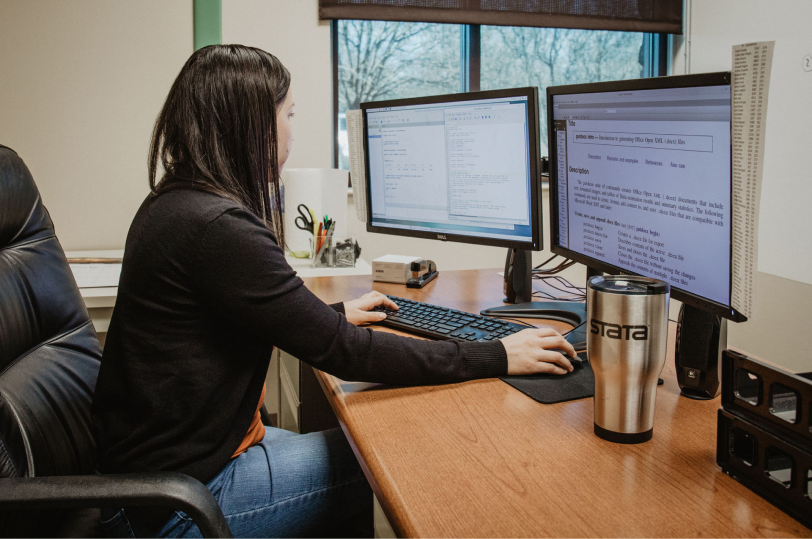

Many colleges, universities, organizations, and businesses have had to transition classes and other operations to online platforms and are asking employees to work remotely. That means they need to be able to use their software even if they don't have access to their usual network, lab, or work computer. We are committed to finding solutions so that everyone can continue using his or her Stata license without disruption, even under these new working arrangements.
Stata is being used worldwide by researchers at the forefront of combating COVID-19.
07.06.2020
The Lancet
06.28.2020
The American Society of Transplantation and the American Society of Transplant Surgeons
06.15.2020
MDPI
05.29.2020
Boston College Department of Economics
05.07.2020
medRxiv
04.23.2020
Centers for Disease Control and Prevention
04.17.2020
Centers for Disease Control and Prevention
03.30.2020
The New England Journal of Medicine
Explore ways to use and visualize data from Johns Hopkins University.
Animate COVID-19 maps
Animate COVID-19 maps
Create COVID-19 maps
Create COVID-19 maps
COVID-19 time-series data
COVID-19 time-series data
Update to Import COVID-19 post
Update to Import COVID-19 post
Import COVID-19 data
Import COVID-19 data
In my previous posts, I showed how to download the COVID-19 data from the Johns Hopkins GitHub
repository, graph the data over time, and create choropleth maps. Now, I’m going to show you how to
create animated choropleth maps to explore the distribution of COVID-19 over time and place.
Learn more
Data analysis plays an important role in the fight against COVID-19. From importing, cleaning, and preparing your data for analysis, performing myriad statistical analyses, to final automated reporting of the results, Stata provides features for all stages of the analysis of infectious diseases such as COVID-19.
And be sure to check out community-contributed features. For instance, create maps of the spread of COVID-19 cases using grmap. Or simulate SIR and SEIR models using Epimodels created by researchers at the World Bank.
As the world is fighting COVID-19, many of us are transitioning to working, teaching, and learning from home. Whether you would like to learn more about Stata or an advanced statistical method or you need some extra resources for teaching Stata in your course, we have online opportunities for you.
If you're a faculty member who introduces Stata to students and are having to move your course online,
we’d like to ease the transition by providing our
NetCourse 101
materials to you at no cost. To take advantage of this offer, simply contact us.
Contact us
We understand that now is a time when learning at home is of utmost importance. Because of that, we are
making the recordings of our previously recorded webinars available for users during this time. Register to access our recordings.
Access webinar recordings
Stata's YouTube channel is the perfect resource for new users to Stata, users wanting to learn a new
feature in Stata, and professors looking for aids in teaching with Stata. We have over 250 videos that
have been viewed over 6 million times by Stata users.
Visit our YouTube channel
This is the data repository for the 2019 Novel Coronavirus Visual Dashboard operated by the Johns Hopkins University Center for Systems Science and Engineering (JHU CSSE). The repository is supported by ESRI Living Atlas Team and the Johns Hopkins University Applied Physics Lab (JHU APL).
Visit JHU GitHubWHO is gathering the latest international multilingual scientific findings and knowledge on COVID-19. The global literature cited in the WHO COVID-19 database is updated daily (Monday through Friday) from searches of bibliographic databases, hand searching, and the addition of other expert-referred scientific articles.
Learn moreCDC is responding to a pandemic of respiratory disease spreading from person to person caused by a novel (new) coronavirus. The disease has been named “coronavirus disease 2019” (abbreviated “COVID-19”). This situation poses a serious public health risk.
Learn moreThe COVID Tracking Project collects and publishes the most complete testing data available for U.S. states and territories.
Learn moreThe Health and Agricultural Policy Research Institute gathers and publishes COVID-19 data from Vietnam, Laos, and Cambodia alongside data for other countries.
Learn moreThe CDCN collects and provides data from trials and publications related to all treatments for COVID-19. The data include the number treated and the results. These data are useful both for physicians and researchers working in new clinical trials.
Learn moreThe COVID-19 Research Database is a collection of resources from public and private organizations such as Datavant, Health Care Cost Institute, Medidata, Mirador Analytics, Veradigm, Change Healthcare, Snowflake and more. The cross-industry collaboration gives public health and policy researchers access to real-world COVID-19 data.
Learn moreThe COVID-19 Development Data Lab Repository aims to provide a backbone of high geographic resolution administrative data to support analysis of and the policy response to the COVID-19 pandemic in India.
Visit Dev Data Lab Github
“I wanted to send a huge shout out to @Stata for making sure my stats students have access now that we are
transitioning to online only instruction.
They moved quickly and handled the situation perfectly! Thanks so much, my students and I both appreciate it!”
Joseph Schwarz
University of Nebraska-Omaha

Learn
NetCourses
Classroom and web training
Organizational training
Webinars
Video tutorials
Third-party courses
Web resources
Teaching with Stata
© Copyright 1996–2024 StataCorp LLC. All rights reserved.
×
We use cookies to ensure that we give you the best experience on our website—to enhance site navigation, to analyze usage, and to assist in our marketing efforts. By continuing to use our site, you consent to the storing of cookies on your device and agree to delivery of content, including web fonts and JavaScript, from third party web services.
Cookie Settings
Last updated: 16 November 2022
StataCorp LLC (StataCorp) strives to provide our users with exceptional products and services. To do so, we must collect personal information from you. This information is necessary to conduct business with our existing and potential customers. We collect and use this information only where we may legally do so. This policy explains what personal information we collect, how we use it, and what rights you have to that information.
These cookies are essential for our website to function and do not store any personally identifiable information. These cookies cannot be disabled.
This website uses cookies to provide you with a better user experience. A cookie is a small piece of data our website stores on a site visitor's hard drive and accesses each time you visit so we can improve your access to our site, better understand how you use our site, and serve you content that may be of interest to you. For instance, we store a cookie when you log in to our shopping cart so that we can maintain your shopping cart should you not complete checkout. These cookies do not directly store your personal information, but they do support the ability to uniquely identify your internet browser and device.
Please note: Clearing your browser cookies at any time will undo preferences saved here. The option selected here will apply only to the device you are currently using.